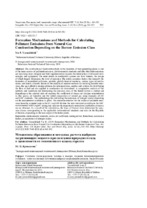| dc.contributor.author | Yarmolchick, Yu. Р. | ru |
| dc.coverage.spatial | Минск | ru |
| dc.date.accessioned | 2019-11-29T08:02:41Z | |
| dc.date.available | 2019-11-29T08:02:41Z | |
| dc.date.issued | 2019 | |
| dc.identifier.citation | Yarmolchick, Yu. Р. Formation Mechanisms and Methods for Calculating Pollutant Emissions from Natural Gas Combustion Depending on the Burner Emission Class = Механизмы образования и методика расчета выбросов загрязняющих веществ при сжигании природного газа в зависимости от эмиссионного класса горелок / Yu. Р. Yarmolchick // Энергетика. Известия высших учебных заведений и энергетических объединений СНГ. – 2019. – № 6. – С. 565-582. | ru |
| dc.identifier.uri | https://rep.bntu.by/handle/data/60959 | |
| dc.description.abstract | The combustion of hydrocarbon fuels in the chambers of heat generating plants is one of the main sources of pollutant emissions. Environmental standards and rules that limit emissions are becoming more stringent and their implementation requires the introduction of advanced technologies and equipment. The main device in combustion systems are blow burners, the design of which largely determines the level of emission. The article considers factors that intensify the formation of normalized pollutants, provides global chemical reactions, various types of mechanisms, and kinetic schemes. Based on the analysis of modern methods for reducing harmful emissions, the most effective design solutions for mixing devices, nozzles and systems for distributing the flow of fuel and air supplied to combustion are determined. A comparative analysis of the methods and conditions for determining the emission class of the burner device is carried out depending on the selected units of measure, the coefficient of excess air (oxygen concentration in flue gases), air humidity and the initial composition of natural gas using examples of EU and EAC standards. The methodology for calculating the emissions of nitrogen oxides depending on the measurement conditions is given. The conversion factors for the values of pollutant emissions from the accepted units in the EU (mg/(kW⋅h)) into the units indicated according to the EAC environmental rules (mg/m3) taking into account the respectively normalized coefficient of excess air are obtained. As a result of the calculations, the types of burners were determined by emission classes corresponding to the applicable environmental standards and rules in the Republic of Belarus, depending on the heat output of the boiler plants. | ru |
| dc.language.iso | en | ru |
| dc.publisher | БНТУ | ru |
| dc.title | Formation Mechanisms and Methods for Calculating Pollutant Emissions from Natural Gas Combustion Depending on the Burner Emission Class | ru |
| dc.title.alternative | Механизмы образования и методика расчета выбросов загрязняющих веществ при сжигании природного газа в зависимости от эмиссионного класса горелок | ru |
| dc.type | Article | ru |
| dc.identifier.doi | 10.21122/1029-7448-2019-62-6-565-582 | |
| local.description.annotation | Сжигание углеводородного топлива в камерах сгорания теплогенерирующих установок – один из основных источников выбросов загрязняющих веществ. Экологические нормы и правила, ограничивающие выбросы, становятся все более жесткими, и их соблюдение требует внедрения передовых технологий и оборудования. Основным устройством в системах сжигания являются дутьевые горелки, от конструкции которых во многом зависит уровень эмиссии. В статье рассмотрены факторы, интенсифицирующие образование нормированных загрязняющих веществ, приведены глобальные химические реакции, различные типы механизмов и кинетические схемы. На основе анализа современных методов снижения вредных выбросов определены наиболее эффективные конструкторские решения смесительных устройств, насадок и систем распределения потоков топлива и воздуха, подаваемого на горение. Проведен сравнительный анализ методов и условий определения эмиссионного класса горелочного устройства в зависимости от выбранных единиц измерения, коэффициента избытка воздуха (концентрации кислорода в дымовых газах), влажности воздуха и исходного состава природного газа на примерах стандартов ЕС и ЕАС. Приведена методика расчета выбросов оксидов азота в зависимости от условий измерения. Получены коэффициенты пересчета значений выбросов загрязняющих веществ из принятых единиц в ЕС (мг/(кВт⋅ч)) в единицы, указанные по экологическим правилам ЕАС (мг/м3) с учетом соответственно нормируемого коэффициента избытка воздуха. В результате расчетов определены типы горелок по эмиссионным классам, соответствующим действующим экологическим нормам и правилам в Республике Беларусь в зависимости от тепловой мощности котельных установок. | ru |

